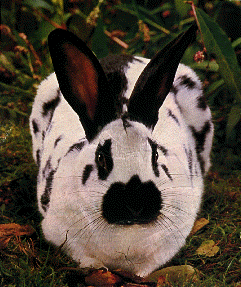

(hares, rabbits, and pikas)
Currently, we recognize 80 living species of lagomorphs, placed in 2 families containing 13 genera. Native populations are found on all continents except Australia and Antarctica; they are absent from southern South America and most islands. Humans have introduced them, however, to many areas where they were originally not part of the fauna.
Lagomorphs are small to medium-sized animals that in many way resemble large rodents. They have a rudimentary or short tail. Folds of skin on the lips can meet behind the incisors so that gnawing can take place with the mouth cavity closed. Other flaps of skin are able to close the nostrils. The skull (especially the maxillary part of the rostrum) is peculiarly fenestrated. The palate is short. Lagomorphs have a pair of incisors in each quadrant of the upper jaw, one large and rodent-like, and the other a small peg located immediately behind the larger tooth. These teeth grow throughout the animal's life and have a layer of enamel that extends around to the posterior surface of the tooth (in contrast to rodent incisors, which have enamel on one face only. As in rodents, canines are absent and a large space (diastema) separates the incisors and the first cheek tooth. The cheek teeth are rootless and hypsodont. The crowns of the cheek teeth are relatively simple, with transverse basins separated by enamel ridges. The dental formula is 2/1, 0/0, 3/2, 2-3/3 = 26-28. The upper toothrows are more widely separated than the lower, so that occlusion can take place on only one side of the jaw at a time. As in rodents, the masseter provides most of the power for mastication; the temporalis muscle is relatively small. Another characteristic of lagomorphs is the location of the testes in males, which lie in front of the penis as in marsupials.
All lagomorphs are terrestrial. They occupy a wide diversity of habitats, ranging from tropical forest to arctic tundra. All are herbivores that feed on grasses and other small plants. Lagomorphs have the ability to produce two types of fecal material, one that is wet and eaten again for further nutrient absorption, and one that is dry and discarded.
The phylogenetic affinities of lagomorphs are controversial, although recent evidence has suggested that they may be related to rodents. But other groups have also been suggested as closest relatives, including marsupials, insectivores, primates, artiodactyls, and other ungulate groups!
families of lagomorpha Family Ochotonidae Family Leporidae<<<<<<<>>>>>>> ARTIODACTYLA CARNIVORA CETACEA CHIROPTERA DASYUROMORPHIA DERMOPTERA DIDELPHIMORPHI DIPROTODONTIA HYRACOIDEA INSECTIVORA LAGOMORPHA MACROSCELIDEA MICROBIOTHERIA MONOTREMATA NOTORYCTEMORPHIA PAUCITUBERCULATA PERAMELEMORPHIA PERISSODACTYLA PHOLIDOTA PRIMATES PROBOSCIDEA RODENTIA SCANDENTIA SIRENIA TUBULIDENTATA XENARTHRA
Email: eradani7@aol.com